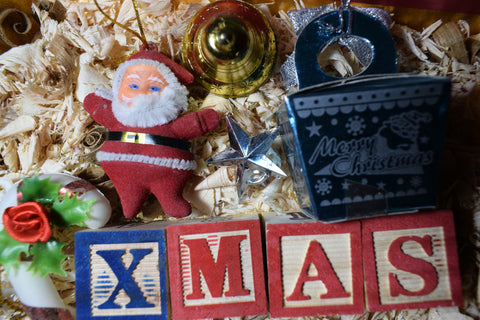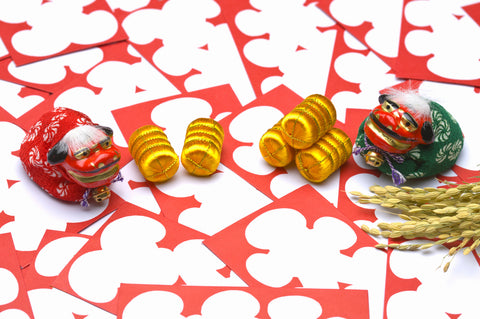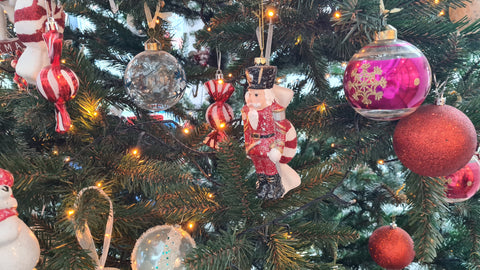Christmas parties or dinners in the UK are generally considered incomplete without Christmas Crackers. Friends and family members gather around the table, grab the ends of a cracker (two people are required to pull a cracker), and pull it apart. With the pop sound, the cracker releases several surprises. Pulling Christmas crackers has been a Christmas tradition for many years. Not only is it fun to pull a cracker along with a friend or family member, but it also reflects family values for tradition that have been upheld by families, even today.
History of Tom Smith Christmas Crackers

Tom Smith was a confectioner in London who traveled to Paris in 1840 and saw the bonbon treats – basically almonds wrapped in a pretty paper. When he came back to London, he created something similar, only he added a small riddle or saying along with the candies he sold. People did not receive it quite well.
However, he did not give up on this idea and began experimenting with fresh ideas. It is said that one night, he was sitting in front of his log fire; the cracks and sparks from the fire inspired him to create the crackers. It is also said that Tom actually bought the recipe for the bang and crack from a fireworks company known as Brock's Fireworks. Tom Smith then introduced his new line of what he called "Bangs of Expectation" in 1861, which he later changed to Cosaque after the French word Cossack.
After trying, he successfully created the Christmas cracker, the holiday custom that bursts with a ‘pop’ comprising a little gift, a paper crown or hat, and a joke. Over the years, Tom Smith frequently created new and innovative cracker patterns.
Paul Fischer made the cracker box label design, and it was registered for copyright protection in 1907 with the Stationers' Company. This organization was responsible for taking care of copyrights during this period. In 1895, the discovery of the wireless telegraph, or radio, by Italian inventor Guglielmo Marconi served as the inspiration for "Marconi Messages."
Heritage Passed Down to Generations
After Tom passed away, his three sons, Walter, Henry, and Tom, took over his growing cracker company. In addition to introducing the hats inside the crackers, Walter also traveled the world in search of fresh concepts for presents to include inside the crackers. He is known to have sourced the gifts from America, Europe, and Japan. The European Epiphany cakes, which are frequently adorned with a paper crown atop, may have served as the model for the crowns. Some theories also say that the thought of wearing a paper crown might have originated from the Twelfth Night celebrations, where a King or Queen was selected to look over the proceedings.
By the 1890's, the company had become incredibly famous and successful. They employed 2000 people and relocated to Finsbury Square in larger premises. In 1953, Tom Smith & Company merged with a company named Caley Crackers.
It was only after Walter took over the company that they manufactured crackers resembling modern-day ones.
Beautiful Themed Crackers

The business slowly created a wide variety of themed crackers. Wedding bands and fake teeth were among the gifts given to bachelors and spinsters or single men and women! There were also crackers honouring war heroes, Charlie Chaplain and suffragettes—women who fought for women's voting rights! Additionally, crackers were made for noteworthy events like coronations. Even now, the British Royal Family has their own brand of crackers!
A special cracker was also made, which contained a solid silver box containing a piece of gold and silver jewelry. It was known as 'Millionaire's Crackers,' and was an extremely costly cracker set.
They also created Louis Wain's Cats Crackers, Telephone Crackers, Crackers from Clubland, Motoring Crackers and more.
Christmas Crackers

Tom Smith’s 'Christmas Tree Crackers' were designed especially for children. The box carried a beautiful illustration representing Christmas – children dancing around a decorated Christmas tree. The label advertises that the crackers contain hats, flags, mottoes for kids, jewels, toys, etc. The label was designed by Gus Rosenthal. The year before this box label was created, Tom Smith & Co. was granted its first Royal Warrant by the then Prince of Wales.
Presently, Tom Smith Christmas crackers are made of little cardboard tubes covered in vibrant paper. On the Christmas dinner table, a Cracker is typically placed next to each plate. When the crackers are pulled, a celebratory joke, a toy, and a bright party hat come out with a bang. The party hats are supposed to represent the crowns that the Wise Men may have worn. Crackers are famous for their poor Christmas jokes.
Did You Know!

On December 20, 2001, parents of students at Ley Hill School and Pre-School in Chesham, Buckinghamshire, UK, created the longest Christmas cracker in history, measuring 63.1 meters (207 feet) in length and 4 meters (13 feet) in diameter.
The biggest Christmas cracker pull was done by 1,478 people at an event at Tochigi Proving Ground, Tochigi, Japan, on October 18, 2009. The vent was organised by Honda Japan.
Britain never forgot their beloved Tom Smith and his family, who invented Christmas crackers. A beautiful memorial water fountain has been built in Finsbury Square, London, which is dedicated to Tom Smith and his family.
Crackers a Part of Christmas
Crackers are now a part of Christmas and are a must-buy for every family. Children, adults, and older people enjoy pulling apart this lovely cracker for a bang, toys, and fun lines.


 Easter 2026
Easter 2026
 Frozen Food
Frozen Food
 Baking
Baking
 Beans, Peas, Soups & Tins
Beans, Peas, Soups & Tins
 Biscuits, Crackers & Cookies
Biscuits, Crackers & Cookies
 Candy / Sweets
Candy / Sweets
 Crisps & Snacks
Crisps & Snacks
 Chemist / Pharmacy
Chemist / Pharmacy
 Desserts
Desserts
 Gravy, Stock & Paste
Gravy, Stock & Paste
 Haggis
Haggis
 Indian Sauces, Paste and Pickle
Indian Sauces, Paste and Pickle
 Jams & Preserves
Jams & Preserves
 Poppy Appeal
Poppy Appeal
 Pot Noodles & Super Noodles
Pot Noodles & Super Noodles
 Scone Mix
Scone Mix
 Gluten-Free / Free From
Gluten-Free / Free From
 Tea Accessories
Tea Accessories
 Teapot & Tea sets
Teapot & Tea sets
 Tea For One
Tea For One
 Sugar & Creamer
Sugar & Creamer
 Tableware
Tableware
 Serveware
Serveware
 Plates & Trays
Plates & Trays
 Bowls
Bowls
 Cups & Saucers
Cups & Saucers
 Mugs
Mugs
 Silverware
Silverware
 Dinnerware - Accessories
Dinnerware - Accessories
 Dinnerware - For Pets
Dinnerware - For Pets
 Victoria Eggs - Hand-Drawn UK Homeware
Victoria Eggs - Hand-Drawn UK Homeware
 Jewelry & Accessories
Jewelry & Accessories
 Sale
Sale
 Christmas Gifts
Christmas Gifts

